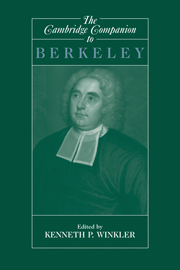Book contents
- Frontmatter
- Introduction
- 1 Berkeley’s life and works
- 2 Was Berkeley an empiricist or a rationalist?
- 3 Berkeley’s notebooks
- 4 Berkeley’s theory of vision and its reception
- 5 Berkeley and the doctrine of signs
- 6 Berkeley’s argument for immaterialism
- 7 Berkeley on minds and agency
- 8 Berkeley’s natural philosophy and philosophy of science
- 9 Berkeley’s philosophy of mathematics
- 10 Berkeley’s moral and political philosophy
- 11 Berkeley’s economic writings
- 12 Berkeley on religion
- Appendix
- Bibliography
- Index
9 - Berkeley’s philosophy of mathematics
Published online by Cambridge University Press: 28 August 2006
- Frontmatter
- Introduction
- 1 Berkeley’s life and works
- 2 Was Berkeley an empiricist or a rationalist?
- 3 Berkeley’s notebooks
- 4 Berkeley’s theory of vision and its reception
- 5 Berkeley and the doctrine of signs
- 6 Berkeley’s argument for immaterialism
- 7 Berkeley on minds and agency
- 8 Berkeley’s natural philosophy and philosophy of science
- 9 Berkeley’s philosophy of mathematics
- 10 Berkeley’s moral and political philosophy
- 11 Berkeley’s economic writings
- 12 Berkeley on religion
- Appendix
- Bibliography
- Index
Summary
Berkeley was concerned with mathematics and its philosophical interpretation from the earliest stages of his intellectual life. As a student at Trinity College, Dublin, he became acquainted with the great mathematical advances of the seventeenth century (including analytic geometry and the calculus), and his interest in mathematics led him to devote his first publication to the subject. This book, Arithmetica et Miscellanea Mathematica, was part of Berkeley's campaign for a fellowship at Trinity, and although it is hardly a great mathematical contribution, it shows his familiarity with the arithmetical, algebraic, and geometric work of the early eighteenth century. Notwithstanding his proficiency in the mathematics of his day and his awareness of its philosophical background, Berkeley followed a decidedly independent and critical course in the philosophy of mathematics. There is, of course, nothing anomalous about this. Berkeley was always prepared to challenge the received views of his predecessors. Just as he approached the metaphysical, epistemological, or scientific doctrines of Descartes, Leibniz, or Newton with a critical (or even hostile) attitude, Berkeley was prepared to challenge their accounts of mathematics, even if this meant rejecting the most widely received principles and successful mathematical theories of his day.
- Type
- Chapter
- Information
- The Cambridge Companion to Berkeley , pp. 266 - 310Publisher: Cambridge University PressPrint publication year: 2005
- 3
- Cited by



